Vol 3 No. 53 TROPIC LIGHTNING NEWS December 30, 1968
Index
Happy 1969, Tropic Lightning!
First Brigade, RFs Encircle,
Crush 100 VC Near Tay Ninh
By SGT Herb Burdett
TAY NINH - In just a few hours elements of the 1st Brigade
reinforced Regional Force elements heavily engaged against VC and NVA forces 14
miles southeast of Tay Ninh City.
The Tropic Lightning soldiers moved from their position nine miles
northwest of Tay Ninh to bolster their Vietnamese allies in their fight against
an estimated NVA battalion.
Within minutes after receiving the word, companies C and D of the
3d Battalion, 22d Infantry, Regulars were preparing to lift off from fire
support bases Washington and Buell. Bravo Battery, 7th Battalion, 11th
Artillery, was on its way to Fire Support Base Hull five miles southeast of Tay
Ninh to train its big guns south toward the area of contact.
Daylight was fast disappearing when companies C and D flew into the
contact area “We sure landed in a very hot spot,” said First
Lieutenant Donald I. Haramoto of Makawai Maui, Hawaii, Charlie Company
commanding officer, “There were rice paddies all around us and a small
nearby village full of VC.”
Company D, commanded by First Lieutenant Dale N. Richey of
Fayetteville, N.C., came in on the heels of Company C and also received a hot
reception.
The Regulars quickly consolidated their forces establishing a
defensive perimeter, girding themselves for a night of combat. “We began
receiving rounds from the rice paddies and hamlets to the south,” said
Sergeant Eric Morris of San Francisco, Calif. “It was good time for some
support.”
“The flares are so bright I can easily see the whole area,”
radioed the Forward Air Controller. “Very fine,” replied Lieutenant
Colonel Alexander Hunt of Wealder, Tex., commanding officer of the 3d Battalion.
“Your target is the rice paddy bounded on the right by a long hedgerow.”
Soon the strikes were on the way, pounding the enemy soldiers who
decided to try to hold their own. In all, 26 air strikes were called in on
the enemy that night and the following morning.
While the aircraft were blasting away, the Regulars finished
establishing their night defensive positions, sealing off an important area of
escape for the trapped VC and NVA. Regional Forces and American forces had
forged an ironclad ring around the enemy-infested area.
It started around 2:15 a.m. A torrent of RPG rounds, mortars
and automatic weapons fire rained in on the defensive perimeter. The VC
tried to break out through Charlie Company’s section of the perimeter.
“They walked up along a nearby road. Boy, what nerve,”
said Specialist 4 Jim Rodgres of Blythville, Ark.
A VC RPG team was drawing a bead on a group of four defenders when
an M79 round put an end to their night’s activities. A Kit Carson Scout
with Company C had knocked them out with a single round.
Despite the heavy RPG and mortar barrage, the determined effort by
the trapped VC to break toward the Cambodian border was an utter failure.
When morning came the Regulars and the Regional Forces prepared to
sweep the area. The search revealed a total of 96 enemy dead, their bodies clad
in forest green uniforms either impaled on the wire or lying nearby.
The 128th Helicopter Company cruising the area in support paid the
enemy back for the many aircraft rounds fired at its choppers from around the
hostile area. Just five miles northwest of the contact area they spotted
five NVA soldiers in a bunker, engaged them with rockets and got a body count of
four.
In all, allied infantry and support accounted for a total of 100
enemy killed while suffering light casualties.
Helicopter Relays GI Messages
DAU TIENG - “Tango ... Tango. This is Dustoff Seven Zero back on
station. What’s the situation down there, old buddy?”
For a platoon leader pinned down below by the raking fire of enemy
machine guns, those were welcome words.
Staff Sergeant Dawson Jones of Bessemer, Ala., of a company of the
4th Battalion, 9th Infantry Manchus, was lying in an open field ten miles
southeast of Tay Ninh City, unable to move as a Viet Cong force of unknown size
continued to level automatic weapons fire over the area.
Minutes earlier, the Manchus, under operational control of the 2d
Battalion (Mech), 22d Infantry, had touched down on a helicopter assault into a
cold landing zone.
Suddenly a wall of fire opened up from both flanks as Viet Cong let
loose from fortified bunker positions in tree lines. Trapped, the 3d Brigade
(Continued on Back Page)
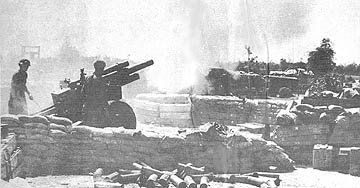 |
TROPIC LIGHTNING ARTILLERY from the 1st Battalion, 8th Artillery provides support for 2d Brigade infantrymen during action near Trang Bang. (PHOTO BY 1LT J. N. BLACK) |
Dragons Take Camp, Kill 15 Viet Cong
CU CHI - In a display of aggressiveness and daring, Golden Dragons
from the 2d Battalion, 14th Infantry, killed 15 VC and captured numerous weapons
while sustaining no friendly casualties.
A heliborne assault of a VC base camp and staging area on the
Oriental River took the enemy completely by surprise.
“We landed right on top of them,” said the commanding officer
of Alpha Company, Captain Wayne A. Downing of Peoria, Ill. “They were
running all over the place, and the gunships cut down three of them as we were
jumping out of our chopper.”
The 2d platoon was the first to encounter the enemy as the lead
element received small arms fire from a hedgerow on their right flank.
“We killed two VC in the woodline before spotting several more
trying to escape by hiding in the river,” stated First Lieutenant William
Norton, 2d Platoon Leader.
The 2d Brigade soldiers pursued the fleeing VC into the river and
accounted for nine more kills as the enemy attempted to hide under water and
behind floating logs.
“In the process of rooting out the VC we discovered they had
thrown many weapons into the water,” said the platoon leader from San
Francisco. “I had passed my M-16 to shore and was helping retrieve them
from the water when suddenly I spotted a VC crawling toward me. I yelled
for a covering element on the opposite bank to open up on him, and I went under
water as they fired over my head - killing him,” Horton continued.
More weapons were found in ten 55-gallon oil drums that had been
sunk in the ground but left uncovered as the VC made their hasty retreat.
The partially underground camp that the Tropic Lightning soldiers
invaded was a large, fully equipped complex containing approximately 50
permanent bunkers, four mess halls, a hospital complete with litters, plasma,
and surgical instruments capable of handling one hundred patients. There were
numerous sampan ports leading onto the river.
“I would contribute the total success of our mission to the
aggressiveness of my men,” stated Downing. “They went right in there
without any confusion and caught the VC by surprise.”
In addition to the 15 dead enemy and three detainees, the Fire
Brigade soldiers also captured two RPG-7 launchers, one 60mm rounds, ten 106
recoilless individual weapons, 33 AK-47 magazines, 3,750 rounds of AK ammo, four
radios, five claymore mines, four field phones, one pair of binoculars, three
pounds of documents, three pounds of medical supplies, and eight NVA web belts.
The Golden Dragons destroyed two 75mm rounds, twelve 60mm rounds,
ten 106 recoilless rifle rounds, 500 RPG-7 rounds, eleven RPG-2 rounds, three
2mm mortar rounds, 1500 rounds of small arms ammo, four sampans, and 35 bunkers.
Page 2 TROPIC LIGHTNING NEWS December 30, 1968
Decorated
| ARMY
COMMENDATION MEDAL (HEROISM) |
|
|
1LT Gregory Gross, A Co, 3d Bn, 22d Inf 1LT John Law, B Co, 3d Bn, 22d Inf 2LT Gary G. Miller, C Co, 3d Bn, 22d Inf WO1 Robert Spitler, B Co, 25th Avn Bn PSG Jesus Flores, HHC, 4th Bn, 23d Inf SSG Grover R. Hicks, HHC, 4th Bn, 23d Inf SSG Alan W. Jones, D Btry, 3d Bn, 13th Inf SSG James Gilbert, HHC, 1st Bde SGT Charles Kennedy, A Co, 1st Bn, 5th Inf SGT Theodore Hale, A Co, 3d Bn, 22d Inf SGT Charadine Lewis, A Co, 3d Bn, 22d Inf SGT Cleveland Minson, D Co, 2d Bn, 12th Inf SGT William Bennett, HHC, 3d Bn, 22d Inf SGT David Guider, A Co, 1st Bn, 5th Inf SGT Anthony Beckler, A Co, 1 st Bn, 5th Inf SGT Ernest McComas, C Cc, 3d Bn, 22d Inf SGT Michael L. Hamrick, D Btry, 3d Bn, 22d Inf SGT Leroy Scott, D Cc, 2d Bn, 27th Inf SGT Arlie Griffus, D Co, 2d Bn, 27th lnf SGT Terrance M. Null, C Troop, 3d Sqdn, 4th Cav SGT John R. Millikan, D Co, 2d Bn, 27th Inf CPL Harvey Simpson, A Btry, 7th Bn, 11th Arty SP4 Glen L. Laroche, C Trp, 3d Sgdn, 4th Cav SP4 Harold Donnelly, C Trp, 3d Sqdn, 4th Cav SP4 Bernard Rairie, D Co, 3d Bn, 22d Inf SP4 Laurence R. Spaulding, A Btry, 3d Bn, 13th Arty SP4 Robert L. Taylor, D Co, 2d Bn, 27th Inf SP4 Baron McGhee, C Co, 3d Bn, 27th Inf SP4 James H. Doggett, C Cc, 3d En, 22d Inf SP4 William Weber, B Trp, 3d Sqdn, 4th Cav SP4 Timothy Andrews, A Btry, 3d Bn, 13th Arty SP4 John Salazar, HHC, 4th Bn, 23d Inf SP4 William Loethen, HHC, 4th Bn, 23d Inf SP4 Jeffery Garrison, B Trp, 3d Sqdn, 4th Cav |
SP4 Roger Colwell, B Cc, 4th Bn, 23d Inf SP4 Lon Zimmerman, A Cc, 25th Avn Bn SP4 Raymond Islas, D Co, 2d Bn, 12th Inf SP4 Edwin Alt, C Co, 4th Bn, 9th Inf SP4 Oscar Cole, D Cc, 2d Bn, 12th Inf SP4 Clarence Wilson, B Trp, 3d Sqdn, 4th Cav SP4 Dewey Hasty, HHC, 4th Bn, 23d Inf SP4 Randolph Evans, A Co, 1st Bn, 5th inf SP4 Gerald Kanoza, B Cc, 3d Bn, 22d Inf PFC James Scannell, A Co, 1st Bn, 5th Inf PFC Daniel Berthold, D Cc, 3d Bn, 22d Inf PFC William Geraghty, B Trp, 3d Sqdn, 4th Cav PFC Herman Burnette, B Trp, 3d Sqdn, 4th Cav PFC Robert Ingersoll, A Co, 3d Bn, 22d Inf PFC Thomas Sawyers, A Co, 3d Bn, 22d Inf PFC Willie Chambliss, A Cc, 3d Bn, 22d Inf PFC Ronald Howard. D Co. 3d Bn. 22d Inf PFC Edward Rossborough, A Co, 3d Bn, 22d Inf PFC Robert Scameheorn, A Co, 3d Bn, 22d Inf PFC Robert Bowlin, D Co, 3d Bn, 22d Inf PFC David Lahr, A Co, 3d Bn, 22d Inf PFC Paul Derrick, A Co, 1st Bn, 5th Inf PFC Lawrence Cochran, D Co, 3d Bn, 22d Inf PFC Richard Astin, D Co, 3d Bn, 22d Inf PFC Charles Best, D Co, 3d Bn, 22d Inf PFC Joseph Hennig, A Co, 3d Bn, 22d Inf PFC John Ballenger, D Co, 3d Bn, 22d Inf PFC Jerry Benson, D Co, 3d Bn, 22d Inf PFC Dennis Beaika, D Co, 3d Bn, 22d Inf PFC Vernon Washington, A Co, 1st Bn, 5th Inf PFC John Martin, D Co, 3d Bn, 13th Arty PFC Michael L. Hunter, B Co, 1st Bn, 5th Inf PFC Ronald Caldwell, D Btry, 3d Bn, 13th Arty |
Justice Act Streamlines The UCMJ
President Johnson made the following remarks on signing the
Military Justice Act:
The soldier who fought at Valley Forge could expect only
‘drumhead justice’ if he ran afoul of military law. The trooper at
Gettysburg could expect little more.
Even the doughboy who went ashore with Pershing had nothing like
the legal protection of the civilian at home.
That has changed now. The man who dons the uniform of his
country today does not discard his right to fair treatment under law.
The first great step came in 1950. It was then that our
servicemen and women were given the Uniform Code of Military Justice, the most
sweeping development in military law in all our history.
Today we advance again. The Military Justice Act of 1968,
which we sign now, will stand proudly next to the 1950 law. It expands the
concept of fairness by creating an independent court system within the military,
free from command pressures and control.
It enlarges the rights of the individual soldier by giving him
trained legal defense when he is tried by a special court-martial. It
makes many other changes to streamline the system, and to safeguard the
serviceman.
Tropic Lightning Tots
The Commanding General Welcomes
The Following Tropic Lightning Tots
To The 25th Infantry Division – As
Reported By The American Red Cross.
Born To:
| December 2 SGT and Mrs. William Ellis, Co A, 725th Maint Bn, a son SGT and Mrs. Tomas W. Sorrell, LCIC, a daughter PFC and Mrs. Lloyd M. Wood, Co E, 65th Engr Bn, a daughter December 3 SGT and Mrs. David V. Sampson, Co A, 125th Sig Bn, a son December 4 PVT and Mrs. Donald W. Norman, Co C, 1st Bn, 5th Inf, a son December 5 SP4 and Mrs. Joseph N. Beatty, 25th Admin Co, a son PFC and Mrs. Michael F. Plagens, HHT, 3d Sqdn, 4th Cav, a daughter December 6 CPT and Mrs. Thomas J. Marr, 3d Bn, 13th Arty, a daughter December 8 SP4 and Mrs. Robert H. Phillips Jr., Co B, 1st Bn, 5th Inf, a daughter |
New Year’s Resolution - Safety!
The month of January 1969 has been designated as USARV SAFETY
MONTH.
The intent of establishing a safety month is to focus command-wide
attention on the overall USARV safety program.
The goals during the month of January are not only to achieve a
substantial reduction in the present high accident rates but to instill an
improved degree of safety consciousness in each soldier.
The prime targets of this program are accidental gunshot wounds,
Army motor vehicle accidents, burn injuries and water safety.
Accidents in these categories continue to occur in ever increasing
numbers.
Tropic
Lightning
Combat Honor Roll
 Added to the Tropic Lightning Combat Honor Roll this week is
Specialist 4 Barry L. Aumiller of Company A, 2d Battalion, 27th Infantry
Wolfhounds.
Added to the Tropic Lightning Combat Honor Roll this week is
Specialist 4 Barry L. Aumiller of Company A, 2d Battalion, 27th Infantry
Wolfhounds.
Aumiller distinguished himself by heroic actions on November 28,
1968.
While established in their night defensive position, the company
came under a massive communist, ground assault.
Spying an insurgent preparing to throw a grenade into a comrade’s
bunker, Aumiller exposed himself to the intense fire and killed the Viet Cong.
He observed three aggressors about to assault his unit’s command
post and single-handedly pursued the enemy, killing the three aggressors.
His valorous actions were responsible for preventing the
destruction of his unit’s command post, and the defeat of the numerically
superior force.
His bravery and devotion to duty are in keeping with the highest
traditions of the military service and reflect great credit upon himself, his
unit, the 25th Infantry Division and the United States Army.
The TROPIC LIGHTNING NEWS is an authorized publication of the 25th
Infantry Division. It is published weekly for all division units in the Republic of
Vietnam by the Information Office, 25th Infantry Division, APO San Francisco
96225. Army News Features, Army Photo Features, Armed Forces Press Service and Armed
Forces News Bureau material are used. Views and opinions expressed are not necessarily
those of the Department of the Army. Printed in Tokyo, Japan, by Pacific Stars and
Stripes.
MG Ellis W. Williamson . . . . Commanding General
MAJ Andrew J. Sullivan . . . Information Officer
2LT Don A. Eriksson . . . . . . Officer-in-Charge
SP4 Stephen Lochen . . . . . . Editor
SP5 Robert C. Imler . . . . . . . Assistant Editor
SP4 Tom Quinn . . . . . . . . . . . Production Supervisor
Page 3 TROPIC LIGHTNING NEWS December 30, 1968
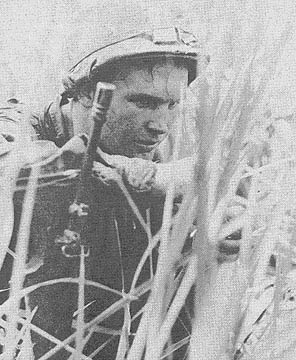 |
WEARY WARRIOR - During a day of fierce battle, Private First Class Terrence Eggen of Plentywood, Mont., pauses a moment in a maturing rice paddy. Eggen is a member of D Company, 2d Battalion of the 12th Infantry. (PHOTO BY SP4 CHARLES HAUGHEY) |
Other War Goes Well As 1st Bde
S-5 Projects Enhance GVN Image
By 2Lt. Mack D. Gooding
TAY NINH - The two wars in Vietnam are going well for allied
forces. At every turn the enemy has been thwarted in his attempts at
military conquest of the South, and he has been thwarted in his attempts at
political conquest as well.
The major factor in his failures in the political war in huge Tay
Ninh Province, on the Cambodian border, is the 1st Brigade Civic Action (S-5)
section. Under the leadership of Major Clarence M. DeYoung, of San Diego,
Calif., the S-5 section has aggressively embarked on a half dozen major projects
during the month of November.
The main emphasis for November was on the PSYOPS (Psychological
Operations) programs designed to win the confidence of the people. “One
of the precepts of a successful S-5 program is to include the local officials
wherever and whenever possible. In this way, we are not bringing glory to
Americans, but are showing the people that the Saigon government is their
government,” said De Young.
One of the more successful programs has been the VIP (Voluntary
Information Program). Under this program, civilians are paid for
information of value to allied forces. Payments are made at the lowest
level practicable.
During November, more than 75,000 piasters were paid to civilians
in Tay Ninh Province for information ranging from the location of a single round
of small arms ammunition to the location of a VC/NVA platoon.
In November, the 1st Brigade S-5 section conducted 146 MEDCAPs
(Medical Civic Action Program), treating 13,911 patients and distributing more
than 350,000 posters and leaflets.
“Most of these have been in outlying hamlets. We’re on
top of the situation in Tay Ninh City and we’ve turned our attention to the
small hamlets that have felt the ravages of war. We let these people see
that they have not been forgotten and that the Government of Vietnam is
interested in them and in gaining their confidence,” said Captain Charlie W.
Smith of Atlanta, Ga., the assistant S-5.
One of the more interesting MEDCAPs is conducted weekly in Phuoc
Tan. Phouc Tan is located less than 1,400 meters from Cambodia in a remote
corner of Tay Ninh Province.
Accessible only by air, the entire population of the hamlet (150)
shows up for every MEDCAP. “After we have treated all the patients, the
Province Chief, Colonel Nguyen Thong, talks to the people and passes out
leaflets and T-shirts and soap.
“We get quite a bit of information from Phuoc Tan, but more
important, the province chief, roughly equivalent to a governor of a state, has
face-to-face contact with people who have never seen a representative of the GVN
before - and they are impressed by Colonel Thong.”
During the month of November, the S-5 section has distributed,
through local officials, 1,500 T-shirts, 500 balls, 500 kites and 1,200 school
kits. All of these items bear the slogan, “Your future lies with the GVN.
I support the GVN”. The appeal is simple, but effective.
Not all of the gifts carry political messages. For instance,
last month the S-5 section distributed 3,000-bars of soap to medical patients
and 1,000 health kits. The enclosed literature simply gave instruction on
the use of the items and basic health education. There was no political
message, but the recipients know where the much-needed health items came from,
and therein was the softsell political message.
The self-help program received renewed emphasis during November.
The S-5 section furnished materials to the Long Hoa school; and the students,
their parents, and school officials provided the labor.
Years from now, members of the S-5 section will have something
“constructive” to reply when asked, “What did you do in the war, daddy?”
LCLC Grads Get Fiery Final
CU CHI - A class approaching graduation from the Lightning Combat
Leadership Course (LCLC) took their final exam under fire near Cu Chi when the
last exercise in the course, an all-night ambush patrol, came under fire.
On December 12 a platoon of students led by Staff Sergeant John N.
Montgomery of Gallie, Fla., an LCLC instructer, left Cu Chi.
The patrol was about 600 meters out of the gate at 7:30 p.m. when
the scout dog alerted, and his handler spotted a VC. A fire fight developed, and Montgomery estimated from the
fire that they were in contact with an enemy platoon. The patrol’s
grenadier, Sergeant Raymond Thomas of Phoenix, Ariz., expended 42 of the 45
rounds fired in the brief but heavy exchange.
“He was putting out the rounds, blowing up the place,”
Montgomery said.
The patrol broke contact, dropped back 300 meters and called in
artillery from the 1st Battalion, 27th Artillery.
“We saw one secondary explosion, so they must have had something
stockpiled in there,” said Montgomery.
Private First Class Jerry C. Molan of Lebanon, Ore., was the
student patrol leader on the ambush patrol. It was his first taste of
combat.
“I was just thankful to the school for teaching me some of the
finer points. I was scared, sure, but I knew what to do,” said Molan.
The assistant student patrol leader, Private First Class Fred
Jenkins of Covington, La., learned his lessons too.
“The school is great,” he said. “It was a big help in
teaching me how to deal with Charlie.”
The men on the ambush patrol returned to Cu Chi
at 8 a.m. from the roughest final exam they’ll ever take.
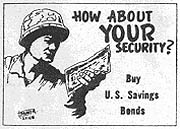 |
Follow Noise In The Bushes,
Wolfhounds Get Ammo Cache
DAU TIENG - A mysterious rustling sound in nearby brush led
Wolfhounds of Bravo Company, 1st Battalion, 27th Infantry to a cache including
more than 200 anti-tank RPG rocket grenades.
A point man, Private First Class Raymond J. Mosley of Waterloo,
La., and four other Tropic Lightning infantrymen of the 3d Brigade, were sent to
investigate the noise, apparently made by a departing enemy.
The Wolfhounds were sweeping through heavy vegetation of the
Trapezoid, 35 miles northwest of Saigon.
“We found a bunker complex, so we called the platoon tunnel
rat,” said Mosley.
The tunnel rat, Private First Class Danny L. Hughes of Keasaugua,
La., crawled through tunnels and trenches while the rest of the platoon checked
the topside of the complex.
Hughes and Sergeant Gary L. Lemonds of Social Circle, Ga., the
squad leader, were the first ones into a bunker which housed the enemy cache.
It included 207 deadly B-41 rounds and seven smaller B-40 rounds and 85 boosters.
Also inside were a carbine and 201 rounds of ammunition. The enemy had
also left behind a typewriter, five pounds of clothing and a hand grenade.
The Wolfhounds called in engineers who destroyed the four bunkers
and several trenchlines and tunnels in the complex.
“All of the RPGs could have put us in a hurt,” commented
Lemonds. “I’m glad we found these rocket grenades before Charlie had a
chance to point them at us.”
Wolfhounds Dig Up Cache Close To LZ
CU CHI - Fire Brigade infantrymen from the 2nd Battalion, 27th
Infantry Wolfhounds located a large enemy rice cache on a sweep near Fire
Support Base Crockett III.
The 3d platoon, Alpha Company soldiers had just landed and were
only 200 meters from the LZ when they made the find.
Private First Class Howard Williams was walking just behind the
pointman when he looked to one side and saw something shiney and knew it
didn’t belong there. It turned out to be a Viet Cong poncho.
Under the poncho were 1,500 pounds of rice in 50 pound bags.
After securing the rice the Tropic Lightning soldiers made an intensive search
of the area.
Private First Class Blairs Stillwell, of Trenton, N.J., uncovered a
bunker nearby used by VC as living quarters. “The occupants had left in
quite a hurry; there was rice still cooking inside the bunker,” Stillwell
said.
Also found nearby were 355 fifty-pound bags of rice, two and a half
pounds of medical supplies, 30 cannisters of glucose, and a pottery container of
documents.
| FIREPOWER ON THE MOVE - A tank from Company A, 2d Battalion, 34th Armor Dreadnoughts provides fire power for a 2d Brigade reconnaissance in force northeast of Cu Chi. (PHOTO BY SP4 DOUG ELLIOT) |  |
Page 4-5 TROPIC LIGHTNING NEWS December 30, 1968
Tropic Lightning Review – 1968
| JANUARY began a busy year for Tropic Lightning. The 1st Brigade moved to Tay Ninh base camp as Operation Yellowstone saw the division combing the area north of Cu Chi. A five mile tunnel complex, considered a main infiltration route was uncovered in the Iron Triangle. The month saw the 3d Brigade at Soul Cut beat back savage ground assaults to kill 382 enemy in one night. Then the 1st Battalion, 27th Infantry killed 191 more enemy while a record rice cache of 231 tons was uncovered. |  |
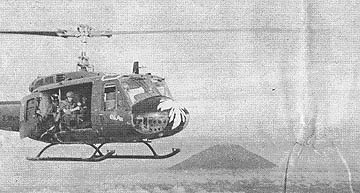 |
FEBRUARY saw action increase as the Tet Offensive gained impetus. Over 750 enemy were killed in a three week period between Cu Chi and Saigon as Operation Saratoga commenced. Flashing action was evident such as when the 2d Battalion, 27th Infantry Wolfhounds smashed through 250 meters of bunkers, machine gun nests and trenches to help a 3/4 Cav platoon in the Hobo Woods, killing 68 enemy. Then B Troop, 3/4 Cav raced kilometers from the Trang Bang Bridge to Tan Son Nhut to aid a sister troop and halt the enemy as part of a battle which killed 400 enemy. |
| MARCH saw the end of Operation Saratoga and the end of tri-brigade action between the Saigon River and Cu Chi. Two hundred forty three enemy died in the first week. Operation Resolved To Win began, highlighted with such action as the 4th Battalion, 9th Infantry killing 169 enemy 8 kilometers north of Saigon, the 3d Battalion, 22d Infantry taking to the water north of Cu Chi and eliminating 100 enemy and the 2d Battalion, 12th Infantry accounting for 122 more. The new operation swept west from Saigon to the Cambodian border, into the long time Communist stronghold, the Hobo Woods. |  |
 |
APRIL’S pace continued as before with the arrival of Operation Quyet Thang. In some of the bitterest fighting since the Tet Offensive, division elements and ARVN forces killed 470 enemy in three days near the Highway One district capitol which stopped a new offensive against Saigon, wiping out two NVA battalions. Heavy fighting within the limits of Tay Ninh City resulted in 137 enemy killed by the heroic efforts of just 50 Tropic Lightning soldiers who lost only four of their number. The month was wrapped up by the 3d Battalion, 22d Infantry Regulars repulsing an attack on their night position. They killed 124 enemy in that action. |
| MAY saw the second Saigon offensive begin. A task force from the 2d Brigade composed of infantry and armored cavalry killed 134 NVA in a two-day battle 10 kilometers from downtown Saigon. Then, eight kilometers southwest of Cu Chi, four battalions and one troop and an attached armored cavalry regiment backed an NVA battalion to a swamp and decimated it, killing over 350 in three days of heavy fighting. Another NVA battalion lost 218 as it tried to get away from the Saigon area. | 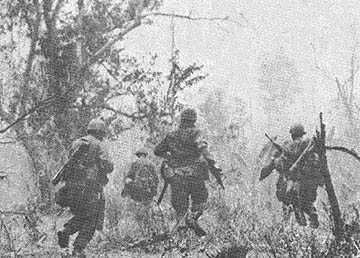 |
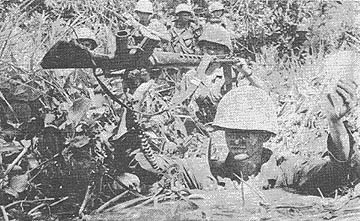 |
IN JUNE, near Cu Chi, 99 enemy were killed in two days while an abortive attack on a 1st Battalion (Mechanized) 5th Infantry night location near Trang Bang left 34 enemy dead. Tropic Lightning, now in Operation Toan Thang I, began combing the area near Saigon for weapons caches and supplies left from the past month’s fighting. Third Brigade soldiers uncovered tons of mortars, rockets and other supplies. The month ended with the 2d Battalion, 27th Infantry killing 71 during an NVA battalion’s attack on their night position 11 kilometers northwest of Saigon. |
| JULY was the month Operation Toan Thang II began, as the division concentrated on rooting out VC personnel, weapons and means of operation. Contact began near Trang Bang as the 2d Battalion, 22d Infantry and ARVN soldiers, working with the 101st Airborne Division, killed 45 enemy. Four division soldiers received the Distinguished Service Cross. The month also saw a ground attack made July 4 on Dau Tieng crushed. |  |
 |
AUGUST will be remembered as the month the enemy launched a massive attack near Tay Ninh and Dan Tieng. Beginning at Fire Support Base Buell II and Nui Ba Den, an estimated regimental size force tangled with Tropic Lightning soldiers during the last weeks of August and the first week of September. In one week, over 900 enemy died, as many as 182 in an hour and a half when the 1st Battalion, 5th Infantry Bobcats counter-attacked in the Ben Cui Plantation. Another highlight was an ambush patrol of the 2d Battalion, 27th Infantry accounting for over 100 enemy near Tay Ninh. Major General Ellis W. Williamson replaced Major General F. K. Mearns as Tropic Lightning commander. |
| SEPTEMBER saw sporadic and fierce fighting after the initial August attack. Fire Support Base Schofield near Dau Tieng beat back an attack, killing 102 enemy. While the division celebrated its 27th anniversary another attack on Fire Support Base Buell II was crushed by the 2d Battalion, 27th Infantry Wolfhounds. In the earlier attack 10 enemy perished. | 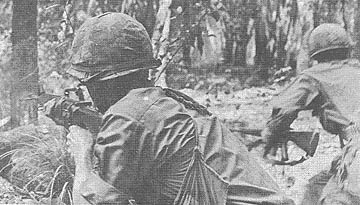 |
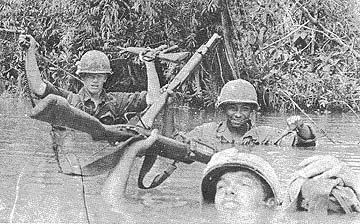 |
IN OCTOBER action slowed and Tropic Lightning again went in search of the enemy and his supplies, rooting out many infrastructure personnel and seriously impairing the Viet Cong organization. The month was highlighted by three ground attacks on the 1st Battalion, 5th Infantry, in five days. Enemy killed numbered 128. |
| NOVEMBER’S activity began around Trang Bang again as 2d Brigade units with elements of the 101st Airborne killed 147 enemy during two days of fighting. The month saw the opening of the Cu Chi Hilton and the Holiday Inn at Tay Ninh for infantrymen “standing down.” After saboteurs blew up the Phu Cuong bridge, a combined engineering effort by US and ARVN forces put up a temporary bridge in less than 26 hours. A new fire support base was established in the Iron Triangle, and the 1st Brigade thrust deep into War Zone C along Route 22 to open up the area near Fire Support Base Phillips. | 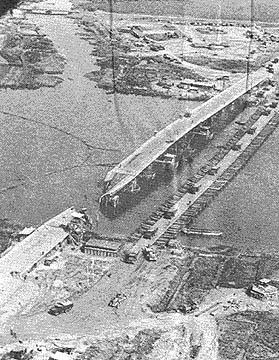 |
 |
AS DECEMBER ends, Tropic Lightning’s never-ending civic action activity and search for the enemy continues. An abortive attempt to ambush a resupply convoy cost the enemy 73 dead near Dau Tieng. Activity has increased near Trang Bang again and thoughts are turning towards the new year ahead. |
Page 6 TROPIC LIGHTNING NEWS December 30, 1968
Regulars” 1968 Record Reveals
Host Of Honors, Valor Awards
DAU TIENG - During the year 1968 the 3d Battalion, 22d Infantry has
proved to be one of the most decorated units in Vietnam.
Since the middle of April the Regulars have been awarded 52 Silver
Stars, four Distinguished Service Crosses, more than a hundred Bronze Stars for
valor and more than 150 Army Commendation Medals for valor.
The Distinguished Service Cross has been presented to Captain
Gerald White, First Lieutenant Phillip C. Bryant, and Specialists 4 Richard
Stuart and David Chedester.
Lieutenant Colonel Alexander H. Hunt of Wealder, Tex., the
Regulars commander, frequently travels to the many locations occupied by the
units under his command to distribute the awards to the recipients.
“It is my intention to have the awards presented to the men in
the presence of those they have served with these many months,” said Hunt.
“An awards ceremony is always of prime importance to the recipient, but also
to his unit and his fellow soldiers. That is why we are conducting the
ceremonies in this manner.”
Colonel Lewis J. Ashley, commander of the 3d Brigade, has heaped
praise on the battalion’s awards and decorations section.
“The 3d of the 22d deserves the high number of awards they are
receiving. Since the beginning of this year the battalion has borne a large part
of the fighting burden in our area of operations and has done outstanding
work,” said Ashley.
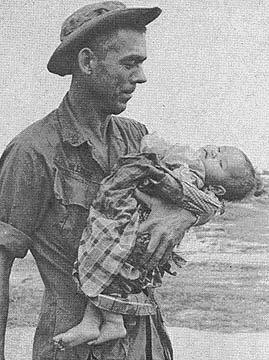 |
HELP ON THE WAY with a medical evacuation chopper only minutes away, Staff Sergeant Edgar D. Bledsoe, Olive Branch, Ill., cradles a critically ill Vietnamese infant. The child was brought to the 2d Battalion, 12th Infantry, night location north of Cu Chi. (PHOTO BY SP4 CHARLES HAUGHEY) |
Cong Shoot At Detainees
CU CHI - Four wounded detainees recently got a taste of their own
medicine, and almost didn’t get a chance to taste ours, when their
‘comrades’ threw a barrage of automatic weapons fire into the ambulance
helicopter that was evacuating them.
The unarmed aircraft piloted by Warrant Officer Theodore C. Jacoby
of the 159th Medical Detachment, 44th Medical Brigade, was clearly marked by its
distinctive Geneva Red Crosses, but it sustained seven hits through the cockpit,
cargo and engine compartment areas.
Oil pressure began to drop and noxious fumes had entered the
cockpit when the pilot made a precautionary landing on Highway 1, near an ARVN
outpost. Another dustoff ship was in the area, and the crew and patients
were taken aboard while the South Vietnamese provided a protective perimeter.
|
PHU CONG II, QUACK, QUACK - First Lieutenant William Ervin of Brunswick, Ga., platoon leader with B Company, 3d Battalion, 22d Infantry, protects the Bravo Company mascot ‘Phu Cong II,’ from dirt and debris. The duck replaces Phu Cong I, a goose that met with a fatal accident on Nui Ba Den. (PHOTO BY SGT HERB BURDETT) |
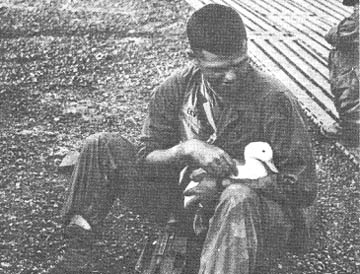 |
Four Cong Catch Warriors’ Wrath
CU CHI - Tropic Lightning soldiers of the Fire Brigade’s 2d
Battalion, 12th Infantry, supported by gunships and air strikes, killed four
enemy and captured a highly prized RPG-7 launcher during a combined U.S.-ARVN
operation near Trang Bang.
“Point elements from the 2d Platoon spotted several Viet Cong
disappearing into a thick hedgerow complex and opened fire,” said Alpha
Company Commander First Lieutenant Richard A. Wiggins from St. Petersburg, Fla.
One enemy was killed in the first moments of contact. An
allied assault then drove the VC into defensive positions where air strikes and
gunships killed three more.
Air Force B-52 Crews Visit Cu Chi
CU CHI - Fifteen Air Force B-52 crew members from the 99th
Tactical Bomb Wing, Strategic Air Command, recently visited the Division base
camp at Cu Chi. The 99th’s home base is in Westover, Mass.
The crew members, 14 officers and one senior enlisted man,
comprising two complete B-52 bomber crews, received a series of briefings on
their mission and effectiveness in operations conducted within the Tropic
Lightning zone of responsibility.
The briefing, conducted by 25th Infantry Division Chief of Staff,
Colonel Gordon W. Summer and representatives of the G-2 and G-3 sections at Cu
Chi, was given at the Tactical Operations Center at the main base camp.
Colonel Summer, in emphasizing the effectiveness of the B-52
bombing program, cited numerous Viet Cong withdrawals into Cambodia and North
Vietnam directly following the air strikes.
G-3 Operations Officer, Major Forrest J. French, a native of Bay
Shore, Long Island, N.Y., explained how decisions are made by Army G-2 and G-3
sections to strike an area with B-52s.
French outlined each step of the call for air stikes from the
initial request at Army Intelligence level to the commanding general’s and
MACV’s approval. After approval, the “Strike Message” is received at
the 99th Bomber Wing’s operations center.
Following the briefing, the men were split into teams of twos and
sent to fire support bases in the 25th’s operational area. The purpose
of the Air Force crew members’ trip into the field was, in Colonel Sumner’s
words, “to see the other side of the attack, the infantrymen’s view.”
Page 7 TROPIC LIGHTNING NEWS December 30, 1968
Nui Ba Den First On Santa’s List
Soldiers of the 1st Brigade scored another first as they were the
initial recipients of Red Cross ‘Ditty Bags’ for the 1968 Christmas season.
The bags were helilifted into a communications complex high atop
Nui Ba Den Mountain in central Tay Ninh Province.
Contents of the bags included soap, wash cloths, playing cards,
stationary, envelopes, recording tapes, candy, nuts, pens, combs, soap dishes,
cigarette cases, nail clippers, gum and a greeting card giving the name and
location of the donating Red Cross chapter in the states.
The 250 Ditty Bags were delivered by Mr. Richard A. Heiens, of
Alton, Ill., acting field director for Tay Ninh West base camp. He was
assisted by Eldon R. Cox, of Odessa, Tex., assistant field director at Tay Ninh,
and Andy B. Moore of South Hampton, Mass., field director from Cu Chi base camp.
The bags were presented to the men under the approving eyes of
Major Walter D. Everhart of Atlanta, Nui Ba Den commanding officer, and Captain
George D. Featherstone of Houston, commanding officer of Bravo Company, 3d
Battalion, 22d Infantry.
The men received their gifts at their duty stations: in bunkers,
manning complicated communications equipment, repairing defensive positions or
pulling KP. Each man appreciated the useful remembrances from the people
back in the world.
|
STORY AND PHOTOS |
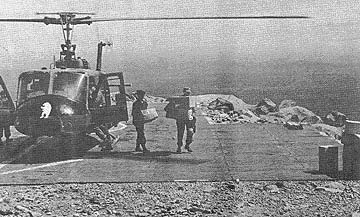 |
RED CROSS ‘ELVES’ UNLOAD GIFTS - Red Cross Field Director Richard A. Heiens from Alton, Ill., and his assistant Eldon R. Cox of Odessa, Tex., unload ditty bags from Colonel Robert L. Fair’s command and control ship. The bags, the first to be distributed in Vietnam this holiday season, were passed out to the 250 defenders of the relay station. |
| CHRISTMAS BAGS DELIVERED - Specialist 4 Tom LaFerry of Chattanooga, Tenn., (left) and Private First Class James Grace of Albany, Mo., pause atop their bunker on Nui Ba Den as Major Everhart passes out the presents to his men. |  |
 |
RED CROSS - Delving into the pile of Christmas Ditty Bags and distributing them to the men of Bravo Company, 3d Battalion, 22d Infantry on Nui Ba Den is Richard A. Heiens of Alton, Ill., field director for the Red Cross at the 1st Brigade. |
| SANTA CLAUS - He may outrank every man on Nui Ba Den, but to the staunch defenders of the strategic mountain top, Major Walter D. Everhart, from Atlanta, Ga., is indeed Santa Claus. He distributed the red and green Red Cross ditty bags to every man. Getting their gifts are (left to right) Specialist 4 Greg Doigneau of Detroit, Private First Class Joe Pinski of Buffalo, N.Y., and Private First Class Dennis Adams of Lebanon, Ore. |  |
Page 8 TROPIC LIGHTNING NEWS December 30, 1968
Manchus’ Favorite Magazines
Turn Out To Be Lifesavers
DAU TIENG - “When he fired, I felt something poking at my side.
A little smoke was coming out of my magazine belt. I didn’t have time to
think much about it.”
That was how a 3rd Brigade infantryman described being hit by a
burst of enemy AK-47 and emerging unscratched.
The rifleman, who was walking point for Alpha Company, 4th
Battalion, 9th Infantry Manchus, was searching a sack of rice he found on a log
table in an enemy eating area while pushing through a hedgerow 11 miles east of
Tay Ninh City.
“I dove for cover behind a heavy wooden bench,” said Private
First Class Gary D. Fiumara of Brooklyn, N.Y.
Fiumara returned fire until he was able to crawl back to the rest
of his platoon, which was just reaching the hedgerow when the firing began.
The Manchus continued searching the area and engaging snipers for
more than an hour, with unknown results.
A lull followed, and Sergeant Gary C. Weyant of Middletown, N. Y.,
a squad leader, came up to talk to the point man.
“Hey, man, your bandoleers are full of holes. What happened?”
asked Weyant.
Fiumara was astounded to find that two belts of ammunition he was
wearing around his waist had absorbed nine rounds of rifle fire. Two
rounds were still lodged in the metal. The smoke he had seen earlier was
apparently caused by burning gunpowder.
“I still can’t believe it,” Fiumara said after his company
returned from the day’s sweep. “I must be one of the luckiest guys
alive.”
 |
HOLDING TWO riddled magazines in a ‘V for victory’ symbol, a Manchu infantryman of the 4th Battalion, 9th Infantry, shows bullet holes from enemy fire that left him unharmed when it struck his ammunition belts. The 3d Brigade rifleman Private First Class Gary D. Fiumara of Brooklyn, N.Y., took nine hits in his magazines. (PHOTO BY PFC H. J. TSCHIRNER) |
Warrior Fire Wakes Napping Viet Cong
CU CHI - Tropic Lightning infantrymen of Bravo
Company, 2d Battalion, 12th Infantry, killed five enemy soldiers and apprehended
four suspects in a day of sporadic contact 10 miles north of Cu Chi.
“We caught them napping,” according to 1st platoon rifleman
Specialist 4 John Washington from Macon, Ga. “Some were lying in
hammocks near a hootch; others, wearing web gear just standing around as though
waiting for instructions.”
The first platoon point element opened fire on the VC who broke and
ran. Within minutes the Fire Brigade soldiers began receiving small arms
and automatic weapons fire from the front. “When we began to get fire
from our right flank it was time to call for gunships and air strikes,” said
Sergeant Larry Fontanna of Napa, Calif.
After nearly an hour of continuous aerial bombardment, the 2nd
Brigade soldiers assaulted the enemy positions. “We moved on line; if
any of them got out they had to have gotten out fast,” said Private First
Class Robert Delaperriers, Levitown, Pa.
The fleeing enemy left fast enough to neglect taking along two
highly prized RPG-2 launchers, five individual weapons and 1,500 rounds of ammo,
10 grenades and documents.
In addition to the five enemy killed by infantrymen, three more
were killed by supporting gunships three miles east of Trang Bang.
“It was a heads-up operation for Bravo Company. They’re
working as a fine team,” commented Lieutenant Colonel Thomas Driessenstok,
White Warrior battalion commander from Washington, D.C.
Helicopter Relays Messages...
(Continued From Page 1)
troops were unable to even crawl out of the deadly crossfire. At the same time,
they became separated into two elements.
Immediately two radios were knocked out and Jones was left with his
element’s only link to help. He was able to talk to the “Triple Deuce”
battalion command post, but their return messages were garbled.
At that moment Dustoff Seven Zero, arriving on station in response
to a call for help, ascertained the difficulty the two elements were having and
took the role of go-between for the delicate thread of radio communications.
Every message from the trapped company was relayed verbatim to the battalion
command post.
“It was almost as if the pilot of the medevac ship had a
photographic memory,” said Sergeant First Class Augustine V. Cardinali of
Niagara Falls, N.Y., Triple Deuce operations sergeant.
For the next five and a half hours, the medical evacuation
helicopter from the 45th Medical Company (Air Ambulance), 44th Medical Brigade,
remained above the battle, leaving only once to refuel.
Small arms fire continued to harass the stricken Manchus, but the
Dustoff ship braved unknown enemy firepower to bring out the wounded
infantrymen.
Other medevac ships followed as the siege of the beleaguered
company was lifted. Another Manchu company linked up with its sister
company and reestablished communications as the Viet Cong skulked away.
The battle was over.
But the role of the Dustoff ship was not forgotten. Back in
Fire Support Base Wood, Staff Sergeant Jones, praising the role of the
helicopter, said “I hope to meet those guys and shake the hand of everyone
aboard that ship.” Other Manchus agreed that, had not the medevac ship
been there, the toll of the battle might have been worse.
Those aboard the chopper, however, had been nonchalant as the ship
left to carry the wounded to medical attention.
In response to a radioed word of thanks from the ground, the pilot
said simply, “No sweat fellas, anytime. Dustoff Seven Zero, out.”
| THE WHOLE TOOTH - His face contorted with strain as a medic removes a damaged tooth, a patient at a 3d Brigade MEDCAP expresses his temporary displeasure. However, the operation proved a success, and the grateful patient thanked Specialist 5 David J. DiTacchio of Brockton, Mass., of the 40th Medical Detachment. He was one of 47 dental patients at a hamlet near Dau Tieng, 45 miles northwest of Saigon. (PHOTO BY SP4 HECTOR NADAL) |  |
Thanks to
Mack D. Gooding, 15th PID, 1st Bde., for sharing this issue,
Kirk Ramsey, 2nd Bn., 14th Inf. for creating this page.
This page last modified 8-12-2004
©2004 25th Infantry Division Association. All rights reserved.